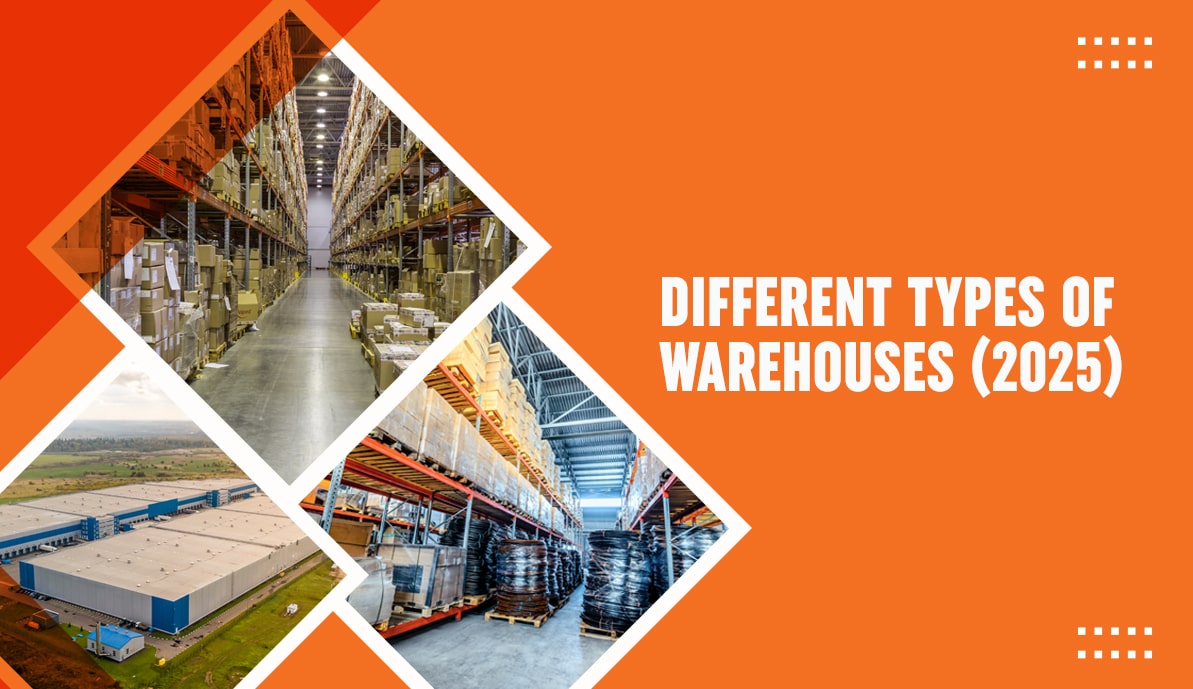Warehouses are not just giant storage units filled with racks of products collecting dust. They are the powerhouses of supply chains, ensuring that goods move seamlessly from manufacturers to retailers and, ultimately, to consumers. The efficiency of a business often depends on choosing the right type of warehouse. With logistics evolving at lightning speed, companies must adapt by selecting facilities that best align with their operations. Whether you’re running a small business, an e-commerce empire, or an industrial-scale enterprise, there’s a warehouse designed to meet your needs. In this blog, you will explore the different types of warehouses and how they contribute to modern business logistics. Also, get some tips on choosing the perfect warehouse and why you should avoid some.
Main Types of Warehouses
Public Warehouses
Public warehouses are storage facilities owned by government entities or third-party logistics providers. They offer businesses an economical way to store their inventory without the burden of owning or maintaining a facility. The biggest advantage? Flexibility. Companies can rent space as needed, making them a perfect choice for seasonal businesses or those experiencing fluctuating inventory levels.
Advantages:
- Cost-effective for businesses that don’t require long-term storage.
- Ideal for startups and small businesses that need temporary inventory space.
- Managed by logistics experts, ensuring smooth inventory handling and distribution.
However, since multiple businesses share the same facility, security concerns may arise, and space availability is not always guaranteed during peak seasons.
Private Warehouses
Private warehouses in Kolkata are owned and operated by a single business for its exclusive use. These facilities are commonly used by manufacturers, wholesalers, and large retailers who need complete control over their inventory. Although they require significant investment, they provide better security, customisation options, and seamless integration with business operations.
Advantages:
- Greater control over inventory management and security.
- Tailored to specific business needs, from layout to technological integrations.
- Long-term cost savings for large-scale operations.
On the downside, private warehouses demand high initial capital investment and ongoing maintenance costs. They are best suited for established businesses with stable storage needs.
Contract Warehouses
Contract warehouses fall between public and private warehouses. Businesses sign long-term agreements with warehouse providers, gaining access to specialised services such as inventory management, packaging, and distribution.
Advantages:
- Lower upfront investment compared to private warehouses.
- Customisable services tailored to business needs.
- Predictable costs due to fixed contract terms.
Contract warehouses are ideal for companies needing reliable, long-term storage without the financial strain of owning a facility. However, contract terms can be rigid, limiting flexibility if the business needs change.
Cooperative Warehouses
Cooperative warehouses are jointly owned by multiple businesses, often within the same industry. This allows companies to share operational costs, making it a cost-effective solution for small businesses and cooperatives.
Advantages:
- Reduces storage and operational costs through shared expenses.
- Encourages industry collaboration and efficiency.
- Accessible to businesses that may not afford private warehouses.
However, cooperative warehouses located on industrial land for sale in Kolkata require businesses to follow collective regulations and management decisions, which may not suit companies requiring independent control.
Automated Warehouses
Automation is transforming warehousing. Automated warehouses use robotics, conveyor belts, artificial intelligence, and automated storage and retrieval systems (AS/RS) to streamline operations and reduce reliance on human labour. These facilities are increasingly popular among large e-commerce businesses and high-volume manufacturers.
Advantages:
- Faster order processing and reduced errors.
- Minimal labour costs due to robotic handling.
- Enhanced inventory tracking with AI-powered management systems.
Despite their efficiency, automated warehouses require significant investment in technology and infrastructure, making them more suitable for large corporations rather than small businesses.
Climate-Controlled Warehouses
Certain products require specific temperature and humidity conditions to maintain quality. Climate-controlled warehouses, also known as temperature-sensitive storage facilities, protect items like food, pharmaceuticals, and chemicals from environmental damage.
Advantages:
- Ensures product integrity by maintaining consistent temperature and humidity.
- Essential for industries dealing with perishable or sensitive goods.
- Reduces risk of spoilage, contamination, or chemical degradation.
These warehouses are indispensable for businesses dealing in frozen foods, medical supplies, or luxury goods such as wine and fine art. However, they come with higher operational costs due to energy consumption and maintenance.
Bonded Warehouses
Businesses dealing with imported goods often use bonded warehouses. These facilities located on industrial land for sale in Kolkata store imported products before customs duties are paid. This allows businesses to defer taxes until goods are sold or exported.
Advantages:
- Defers duty payments, improving cash flow.
- Allows businesses to process goods without an immediate tax burden.
- Often equipped with high-security measures.
Bonded warehouses are ideal for international traders, but they must comply with strict government regulations, making compliance a priority.
Specialised Warehouses Catering to Specific Needs
Distribution Centers
Distribution centres are designed for rapid product movement rather than long-term storage. They facilitate the efficient distribution of goods from manufacturers to retailers or directly to consumers. Companies focusing on speed and efficiency, like retail chains and e-commerce giants, rely heavily on distribution centres.
Advantages:
- Fast turnaround time for goods, reducing inventory holding costs.
- Strategic locations ensure quick delivery to customers.
- Often integrated with advanced logistics technologies.
Fulfillment Centers
E-commerce businesses use fulfilment centres to store, pick, pack, and ship orders directly to customers. These facilities handle high volumes of online orders, ensuring seamless order fulfilment.
Advantages:
- Reduces operational burden for online businesses.
- Offers same-day or next-day shipping services.
- Integrates with e-commerce platforms for efficient order processing.
Fulfilment centres enable businesses to scale operations without managing their own warehouses, but they do involve service fees.
Cross-Docking Facilities
Cross-docking warehouses focus on efficiency by moving products directly from incoming to outgoing transportation, minimising storage time. This model is ideal for perishable goods and industries requiring just-in-time inventory.
Advantages:
- Reduces storage costs and handling time.
- Enhances supply chain efficiency.
- Ideal for fast-moving consumer goods.
However, cross-docking requires precise coordination and reliable transportation networks.
Cold Storage Warehouses
Cold storage warehouse in Kolkata are crucial for the food and pharmaceutical industries, ensuring perishable goods remain fresh and safe. These facilities use advanced refrigeration technology to maintain specific temperatures.
Advantages:
- Extends shelf life of perishable items.
- Essential for food safety and pharmaceutical integrity.
- Reduces waste and spoilage.
Cold storage facilities come with high energy and maintenance costs but are essential for businesses dealing with temperature-sensitive products.
How to Choose the Right Warehouse?
Selecting the perfect warehouse is crucial for business success. A well-chosen warehouse optimises storage, enhances supply chain efficiency, and reduces costs. Here’s how to make the right choice:
Location Matters
Proximity to suppliers, customers, and transportation hubs affects logistics costs and delivery times. A warehouse near key distribution points minimises transit expenses and improves service speed.
Storage Capacity and Scalability
Choose a warehouse that accommodates your current inventory while allowing for future expansion. If your business is growing, a warehouse with flexible storage options prevents frequent relocations and disruptions.
Technology and Infrastructure
Modern warehouses with advanced inventory tracking, automation, and AI-driven management improve operational efficiency. Check if the warehouse offers RFID tracking, real-time inventory visibility, and seamless integration with your supply chain systems.
Security and Compliance
A reliable warehouse should have robust security measures, including surveillance cameras, access controls, and insurance coverage. Ensure compliance with industry regulations, especially for sensitive goods like pharmaceuticals and food products.
Additional Services
Many warehouses provide value-added services like packaging, labelling, and last-mile delivery. Choosing a facility with these offerings streamlines your logistics and saves outsourcing costs.
Cost and Lease Terms
Evaluate the rental cost, maintenance fees, and contract flexibility. Some warehouses offer pay-as-you-use models, which can be beneficial for seasonal businesses. Always negotiate lease terms to align with your budget and operational needs.
Red Flags While Choosing a Warehouse
Avoiding the wrong warehouse is as important as selecting the right one. Here are the red flags to watch out for:
Poor Location and Accessibility
If a warehouse is too far from major highways, ports, or your customers, transportation costs will skyrocket. Delayed shipments lead to unhappy customers and lost business opportunities.
Lack of Proper Security Measures
Warehouses storing valuable goods must have top-tier security. Weak access control, outdated surveillance systems, or frequent theft reports are major red flags.
Inefficient Layout and Storage Issues
A disorganised warehouse with narrow aisles, poor shelving, or a lack of clear pathways can slow down operations. Always check the facility layout before signing a contract.
Outdated Technology and Poor Management
Warehouses without proper inventory management systems, barcode tracking, or automation lead to inefficiencies. If the facility relies on manual processes, expect delays and errors in stock handling.
Hidden Fees and Unclear Lease Agreements
Always review the contract for hidden charges, maintenance fees, and inflexible lease terms. Unexpected costs can strain your budget and impact profitability.
Poor Maintenance and Hygiene Standards
A neglected warehouse with pest infestations, leaking roofs, or poor ventilation poses risks to stored goods. A facility with ongoing maintenance issues is a liability in the long run.
Limited Scalability Options
A warehouse that cannot accommodate future growth forces businesses to relocate frequently. Ensure the facility allows easy expansion based on business demands.
By identifying these red flags early, businesses can avoid costly mistakes and ensure seamless warehousing operations.
Changes You Should Make in a Warehouse After Buying It
Purchasing a warehouse is only the first step. Optimising its efficiency is crucial for long-term business success. Here are the key changes to implement:
Upgrade Storage Systems
Install high-density shelving, pallet racks, and automated storage solutions to maximise space utilisation. Efficient storage systems improve accessibility and streamline inventory management.
Enhance Security Measures
Invest in 24/7 surveillance cameras, biometric access control, and theft prevention systems. Secure warehouses protect valuable inventory and reduce financial losses.
Implement Advanced Inventory Management
Adopt AI-driven inventory tracking, RFID tagging, and cloud-based software for real-time stock monitoring. This reduces errors and enhances order fulfilment speed.
Optimize Warehouse Layout
Reorganise shelving, workstations, and shipping zones to ensure smooth movement of goods. A well-planned layout minimises handling time and improves workflow efficiency.
Improve Energy Efficiency
Upgrade lighting, insulation, and HVAC systems to reduce operational costs. Sustainable energy solutions like solar panels and LED lighting can cut down long-term expenses.
Enhance Worker Safety and Training
Implement safety protocols, provide protective gear, and conduct regular training sessions for employees. A safe workplace boosts productivity and minimises workplace hazards.
Integrate Automation and AI
Deploy automated conveyor belts, robotic picking systems, and AI-powered demand forecasting. Automation speeds up processes, reduces labour costs, and enhances accuracy.
Making these changes ensures that your warehouse operates efficiently, adapts to future growth, and meets industry standards.
The Bottom Line
Selecting the right warehouse depends on your business type, storage needs, and logistics strategy. The right choice can enhance efficiency, reduce costs, and improve customer satisfaction. Investing in an appropriate warehousing solution ensures your supply chain remains robust and competitive in an ever-evolving market.









